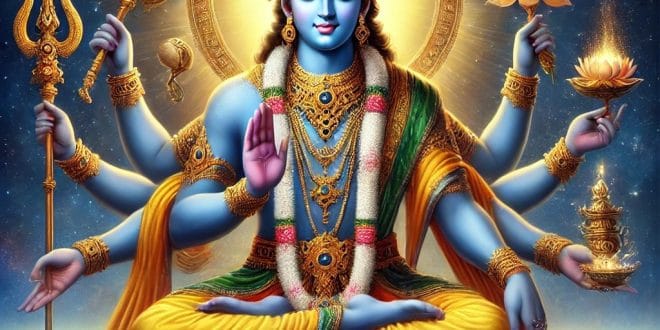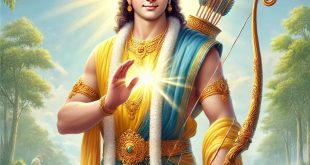In Hindu mythology, Mohini is a fascinating character who embodies the divine feminine form of Vishnu, one of the principal deities in Hinduism. Mohini’s story is captivating, filled with intrigue, symbolism, and profound philosophical insights. In this article, we will delve into the mythological narrative of Mohini, explore her significance, and uncover the deeper meanings behind her portrayal in Hindu mythology.
The Origin of Mohini
Mohini’s origin story is rooted in Hindu scriptures, particularly the Puranas. According to these texts, during a cosmic event known as the Churning of the Ocean (Samudra Manthan), the Devas (celestial beings) and Asuras (demons) sought to obtain the elixir of immortality (amrita) hidden within the ocean. Vishnu, the preserver of the universe, devised a plan to ensure that the Devas emerged victorious in their quest.
Mohini’s Appearance and Transformation
In the midst of the churning, Vishnu assumed the enchanting form of Mohini, a beautiful female figure radiating grace and allure. Mohini’s appearance captivated both the Devas and the Asuras, who were entranced by her celestial beauty. With her divine charm and wit, Mohini cunningly distributed the elixir of immortality to the Devas, thereby securing their victory.
Symbolism and Significance
The mythological tale of Mohini carries profound symbolic significance within Hinduism. Mohini represents the embodiment of Maya, the cosmic illusion that veils the true nature of reality. Through her guise, Vishnu teaches important lessons about the transient nature of material desires and the pursuit of spiritual enlightenment.
Mohini and the Concept of Lila
In Hindu philosophy, the universe is often likened to a divine play (lila) orchestrated by the Supreme Being. Mohini’s role in the cosmic drama exemplifies the concept of lila, wherein Vishnu assumes various forms to maintain cosmic order and guide beings on their spiritual journey. Her appearance as Mohini illustrates the divine playfulness of the universe and the interplay between creation, preservation, and destruction.
Mohini’s Interactions and Influence
Throughout Hindu mythology, Mohini’s interactions with other deities and beings offer insights into her multifaceted nature. She is depicted as a symbol of love, beauty, and compassion, yet also as a cunning strategist and protector of dharma (righteousness). Mohini’s influence extends beyond her role in the Churning of the Ocean, as she continues to appear in various myths and legends, captivating devotees with her divine charm.
Devotion to Mohini
Although Mohini is not as widely worshipped as other Hindu deities, her devotees regard her with reverence and devotion. Some devotees seek her blessings for marital harmony, fertility, or protection from negative influences. Mohini temples and shrines can be found in certain regions of India, where rituals and offerings are performed in her honor.
Contemporary Relevance
The story of Mohini transcends the boundaries of time and culture, offering timeless wisdom and insights that resonate with people across generations. In today’s world, where the pursuit of material wealth often overshadows spiritual values, Mohini’s tale serves as a poignant reminder of the importance of balance and discernment in life.
Mohini in Art and Literature
Throughout history, Mohini has been a popular subject in Hindu art, literature, and performing arts. Paintings, sculptures, and dance performances often depict her in graceful poses, adorned with celestial ornaments and flowing garments. In literature, poets and writers have celebrated Mohini’s beauty and mystique, weaving her into the fabric of mythological epics and romantic narratives.
Mohini’s Role in Moral and Ethical Teachings
Beyond her portrayal as a divine enchantress, Mohini’s story contains valuable moral and ethical teachings. Her actions during the Churning of the Ocean demonstrate the importance of integrity, discernment, and righteous conduct in the face of temptation and adversity. By upholding dharma and ensuring the welfare of the righteous, Mohini exemplifies the qualities of a virtuous and compassionate deity.
Mohini and Gender Fluidity
Mohini’s portrayal as a gender-fluid deity challenges traditional notions of gender and identity in Hindu mythology. As Vishnu assumes the form of Mohini, the boundaries between male and female become blurred, highlighting the fluidity and interconnectedness of all existence. Mohini’s existence transcends binary categorizations, inviting contemplation on the fluid nature of reality and the diversity of human experience.
Mohini’s Teachings on Illusion and Enlightenment
Mohini’s association with Maya, the cosmic illusion, invites deeper contemplation on the nature of reality and the quest for enlightenment. Through her guise, Vishnu teaches that the material world, though alluring and captivating, is ultimately transient and illusory. By transcending the illusions of Maya, one can attain spiritual liberation (moksha) and realize the eternal truth that lies beyond the veil of illusion.
Mohini’s Evolution and Adaptation
Over time, the portrayal of Mohini has evolved and adapted to suit changing cultural and social contexts. In contemporary Hinduism, Mohini continues to inspire devotion and fascination, her story serving as a source of inspiration and contemplation for spiritual seekers and devotees alike. As interpretations of Mohini’s character vary across different regions and communities, her essence remains timeless and universal.
Mohini in Popular Culture
Beyond religious contexts, Mohini has made appearances in various forms of popular culture, including films, television shows, and literature. In Indian cinema, Mohini’s character has been portrayed in mythological dramas and fantasy films, captivating audiences with her beauty and mystical allure. Moreover, her story has inspired contemporary writers and artists to explore themes of love, deception, and divine intervention in modern storytelling.
Mohini Festivals and Celebrations
In some parts of India, festivals and celebrations are held to honor Mohini and her role in Hindu mythology. These festivities often include processions, theatrical performances, and religious rituals that recount her exploits and divine manifestations. Devotees gather to seek blessings from Mohini, offering prayers and offerings to invoke her grace and protection in their lives.
Mohini’s Symbolism in Feminine Power
Mohini’s portrayal as a powerful and alluring female deity underscores the significance of feminine energy and empowerment in Hindu cosmology. Through her beauty, charm, and intelligence, Mohini embodies the Shakti, or divine feminine principle, which is revered as the creative force of the universe. Her story serves as a reminder of the inherent strength and resilience of women, as well as their capacity to wield influence and effect change in the world.
Mohini’s Influence on Dance and Music
Mohini’s graceful form and mesmerizing presence have inspired classical dancers and musicians to create elaborate compositions and choreographies dedicated to her. Dance forms such as Bharatanatyam, Odissi, and Kathak often feature performances that depict Mohini’s divine grace and celestial beauty, captivating audiences with intricate movements and emotive expressions. Similarly, musicians compose devotional songs and hymns praising Mohini’s virtues and divine attributes, celebrating her role as a celestial enchantress.
Mohini’s Universal Appeal
Despite being deeply rooted in Hindu mythology, Mohini’s story transcends religious boundaries, resonating with people of diverse cultural backgrounds and beliefs. Her universal appeal lies in her ability to embody timeless themes of love, desire, deception, and spiritual awakening, which are central to the human experience. Whether worshipped as a divine deity or admired as a symbol of beauty and grace, Mohini continues to captivate hearts and inspire minds around the world.
Mohini, the divine feminine form of Vishnu, continues to captivate the hearts and minds of devotees through her timeless beauty, wisdom, and grace. As we reflect on her mythological significance, may we gain a deeper appreciation for the divine play unfolding within and around us, and may we be inspired to seek truth, beauty, and enlightenment on our spiritual journey.
 Lifeved The Keys to a Better
Lifeved The Keys to a Better



 by
by